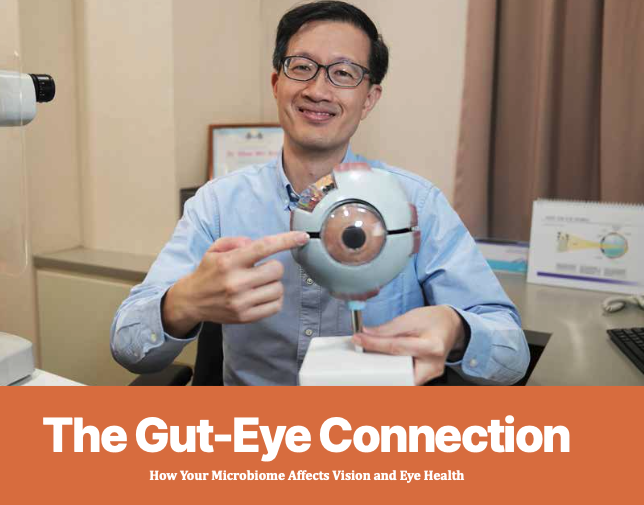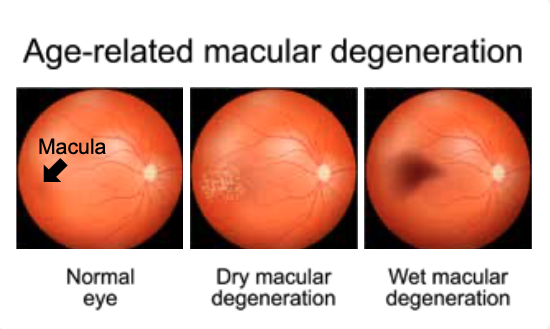How Your Microbiome Affects Vision and Eye Health
Most of us think of gut health in relation to digestion, but did you know that the bacteria in your gut could also affect your eyes? Scientists have discovered a fascinating connection between our gut “microbiome” – the trillions of bacteria, viruses and fungi living in our intestines – and various eye diseases. This gut-eye connection may play a crucial role in regulating inflammation and immune function, which means that an imbalance in the gut microbiome (termed “dysbiosis”) could contribute to eye conditions like age-related macular degeneration (AMD), diabetic retinopathy and dry eye disease. As researchers continue to explore this connection, it is becoming increasingly clear that taking care of your gut might be just as important for your eyes and overall well-being, as it is for digestion.
HOW THE GUT MICROBIOME IMPACTS THE BODY AND EYE HEALTH
A healthy gut contains a finely balanced mix of beneficial and harmful bacteria that helps to regulate the immune system, protect against infections, and produce essential vitamins and metabolites that affect the skin, joints and internal organs. However, when this balance is disrupted, the lining of our intestines may weaken or become “leaky”, allowing harmful substances to enter the bloodstream, and triggering our body’s immune system.
In addition to inflammation, gut bacteria also influence oxidative stress and the production of key compounds, such as short-chain fatty acids (SCFAs), that help to maintain tissue health. Such changes have been linked to a multitude of conditions including obesity, diabetes, heart disease and autoimmune problems like rheumatoid arthritis.
Emerging research suggests that gut dysbiosis can also alter the activity of immune cells within the eye. This can induce chronic inflammation that damages healthy ocular tissues, impact tear production, and even accelerate the progression of degenerative eye conditions. Understanding this link could open up new avenues for treating and preventing different eye diseases.
GUT DYSBIOSIS AND AGE-RELATED MACULAR DEGENERATION
The retina is the light-sensing layer at the back of the eye, and the macula is the part of the retina that is involved with central vision. In AMD, a combination of age-related degeneration and sudden bleeding at the macula can result in the loss of fine vision and colour vision. AMD is a leading cause of vision loss in older adults, and research suggests that gut bacteria may have a role in its development.
Studies in people with AMD have shown that they tend to have a disrupted gut microbiome, with an increase in harmful bacteria and a decrease in beneficial ones. This imbalance can trigger chronic low-grade inflammation, which damages the retina over time. Furthermore, AMD patients often have higher levels of harmful bacterial byproducts in their bloodstream, suggesting that an unhealthy and “leaky” gut may contribute to oxidative stress and immune dysfunction
within the eye.
Our gut also has an important role in the processing of lipids that are consumed in our diet. Changes in gut bacteria can lead to increased production of pro- inflammatory lipids, which contribute to the formation of drusen – fatty deposits that accumulate in the retina and are characteristic of AMD. Encouragingly, early research indicates that dietary changes and probiotics may help to restore a healthier gut environment, potentially slowing AMD progression and preserving vision for longer.
THE GUT’S ROLE IN DIABETIC RETINOPATHY
Diabetic retinopathy is a complication of poorly-controlled diabetes, where damage
to the fine blood vessels of the eye results in bleeding and swelling of the retina. People with diabetes already experience gut microbiome imbalances, and studies have found that those with
diabetic retinopathy have distinct bacterial changes compared to diabetic patients without the condition. These changes include a decrease in beneficial, anti- inflammatory bacteria and an increase in harmful, pro- inflammatory ones.
The gut microbiome also plays a role in glucose metabolism and insulin resistance, which impacts diabetes control and diabetic retinopathy. Certain compounds produced by gut bacteria, such as nicotinic acid and carnosine, are significantly reduced in patients with diabetic retinopathy. These compounds are known to have protective effects against oxidative stress and inflammation, suggesting that their low levels could contribute to retinal damage.
While researchers have found these associations, it is not clear if these changes in the microbiome of diabetic patients are actually contributing to the disease, or if they are just the result of diabetes and its treatment (such as medications). Scientists are now exploring whether probiotics, intermittent fasting, and even faecal transplants could help to prevent or manage diabetic retinopathy by restoring a healthier gut balance and improving diabetic control.
DRY EYE DISEASE AND THE GUT-EYE AXIS
Dry eye disease is a common and often frustrating condition that causes irritation, redness and blurry vision. While it may seem unrelated to the gut, scientists have found experimental evidence that indicates that gut dysbiosis does play a role in the development of dry eye disease.
People with dry eyes often have an imbalance of bacteria in their gut microbiome. In autoimmune conditions like Sjögren’s syndrome, which is strongly associated with dry eye disease, gut bacteria
influence immune responses that directly impact the tear glands. Studies have even demonstrated that transferring gut bacteria from human patients with Sjögren’s syndrome to the gut of mice can lead to these mice developing signs of dry eye disease! Conversely, restoring the gut microbiome with healthy bacteria from normal mice was able to reverse these signs in the study mice, reinforcing the idea that gut microbes help to regulate eye health.
 CAN IMPROVING GUT HEALTH PROTECT YOUR VISION?
CAN IMPROVING GUT HEALTH PROTECT YOUR VISION?
The good news is that targeting gut health could be a way to support eye health, and
the most direct way to do so is to modify our diet. A Mediterranean-style diet, rich in dark green vegetables like spinach, kale and kailan, provides essential antioxidants like zeaxanthin and lutein to help reduce oxidative stress and inflammation in the eyes. Colourful fruits, such as mangoes, berries and citrus, supply beta-carotene, vitamins and polyphenols that support retinal health.
Whole grains, nuts and beans offer a combination of healthy fats, fibre and protein that contribute to a balanced gut microbiome, and provide the necessary fuel for gut bacteria to produce SCFAs like butyrate.
Fermented foods, such as yogurt, kimchi and sauerkraut, also help to increase SCFA levels, which has a role in suppressing inflammation, promoting antibody production, and impacts lipid metabolism. Fatty fish, such as salmon and sardines, are excellent sources of omega-3 fatty acids, which have been
shown to protect against retinal damage and support tear production. By incorporating these nutrient-dense foods into our daily meals, we may enhance our gut health and reduce the risk of vision problems.
Probiotics, which introduce beneficial bacteria to our gut microbiome, have shown promise in increasing tear production and reducing inflammation in dry eye patients. In mice models of diabetic retinopathy, engineered probiotic bacteria have demonstrated protective effects against inflammation and blood vessel damage. However, because every person’s microbiome is different, there is still uncertainty if probiotics (which typically consists of a
single strain of bacteria or a fixed combination of different bacteria) will be effective in every patient. Much more research needs to be conducted before probiotics can be customised and prescribed as a viable treatment for eye diseases.
Faecal microbiota transplantation has also been explored as a potential therapy for eye-related disorders. As the name suggests, faecal matter from a healthy donor is processed and then introduced into a patient’s gut, via a colonoscope, enema or oral capsules. The concept is that the healthy bacteria, viruses and fungi in the donated stool will help repopulate and reverse the dysbiosis in the patient’s gut. Despite the “ick” factor, this therapy has already been used very successfully in specific gut infections. Nonetheless, the role of stool transplants in other gut and systemic illness, including eye diseases, is still in the experimental stage.
CONCLUSION
While more research is needed, it is increasingly clear that the gut and the eyes are more connected than we ever imagined. By taking steps to support a healthy gut microbiome – whether through diet, probiotics or other interventions – we may be able to protect our vision and maintain our eye health well into the future. So, listen to that to that gut feeling – it may well hold the key to clearer vision and healthier eyes! PRIME

















Leave A Comment